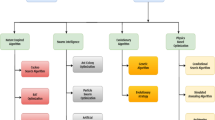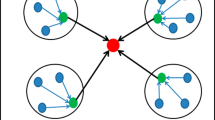Abstract
The clustering methodologies for deployed devices in the region of interest consider the similarity of sensed data or target maximization of network lifetime. Thus the clusters formed are either sensing clusters or communication clusters. In the case of motes capable of sensing multi-feature data, the similarity of sensed parameters is generally used to cluster the devices. Event detection methodologies in uni-modal sensor based IoT mainly focus on communication clusters to maximize network lifetime. Yet, the existing approaches for clustered data gathering hardly incorporate user context and preferences for sensing cluster formation and event detection. Additionally, many approaches do not incorporate both sensing and communication clusters in order to detect the event and balance it with energy efficiency. Research work that considers user context in the domain of the internet of things is also limited with a focus on network lifetime, event detection accuracy etc. The present work aims at resolving the existing constraints in ‘user context’ aware clustering methods and event detection. The user context parameters based on the domain knowledge of the user are used to divide the deployed region into sub-regions forming sensing clusters. The methodology allows the user to change the context and definition of events for each sub-region for accurate, context-aware, and discriminatory event detection. Additionally, the compressive gathering of detected events results in energy efficient data transmission. Simulations were performed for scalability and comparative analysis of the proposed scheme. The results show that the proposed scheme outperforms the existing schemes in terms of detection accuracy and network lifetime.









Similar content being viewed by others
Data availability
No private dataset is associated with the present paper. The link for the publicly available dataset is provided in [32].
References
Malik, P. K., Sharma, R., Singh, R., Gehlot, A., Satapathy, S. C., Alnumay, W. S., Pelusi, D., Ghosh, U., & Nayak, J. (2021). Industrial internet of things and its applications in industry 4.0: State of the art. Computer Communications, 166, 125.
Li, S., Da Xu, L., & Zhao, S. (2018). 5G internet of things: A survey. Journal of Industrial InformationIntegration, 10, 1.
Chen, W. (2020). Intelligent manufacturing production line data monitoring system for industrial internet of things. Computer communications, 151, 31.
Shukla, A., & Tripathi, S. (2020). A multi-tier based clustering framework for scalable and energy efficient WSN-assisted IoT network. Wireless Networks, 26, 3471.
Lu, M., Fu, G., Osman, N. B., & Konbr, U. (2021). Green energy harvesting strategies on edge-based urban computing in sustainable internet of things. Sustainable Cities and Society, 75, 103349.
Xu, L., Collier, R., & O’Hare, G. M. (2017). A survey of clustering techniques in WSNs and consideration of the challenges of applying such to 5G IoT scenarios. IEEE Internet of Things Journal, 4(5), 1229.
Mood, S. Ebrahimi., & Javidi, M. .M. (2020). Energy-efficient clustering method for wireless sensor networks using modified gravitational search algorithm. Evolving systems, 11(4), 575.
Shivhare, A., Singh, V. K., & Kumar, M. (2020). Anticomplementary triangles for efficient coverage in sensor network-based IoT. IEEE Systems Journal, 14(4), 4854.
Albreem, M. A., Sheikh, A. M., Alsharif, M. H., Jusoh, M., & Yasin, M. N. M. (2021). Green internet of things (GIoT): Applications, practices, awareness, and challenges. IEEE Access, 9, 38833.
Mukherjee, A., Goswami, P., Yang, L., Yan, Z., & Daneshmand, M. (2020). Dynamic clustering method based on power demand and information volume for intelligent and green IoT. Computer Communications, 152, 119.
Wallis, K., Schillinger, F., Backmund, E., Reich, C., & Schindelhauer, C. (2020). In 2020 Fourth world conference on smart trends in systems. Security and Sustainability (WorldS4) (IEEE, 2020), pp. 7–14.
Perera, C., Zaslavsky, A., Christen, P., & Georgakopoulos, D. (2013). Context aware computing for the internet of things: A survey. IEEE Communications Surveys & Tutorials, 16(1), 414.
Medhat, F., Ramadan, R. A., & Talkhan, I. (2012). In 2012 Seventh international conference on broadband, wireless computing, Communication and Applications (IEEE, 2012), pp. 367–372.
Almusaylim, Z. A., & Zaman, N. (2019). A review on smart home present state and challenges: Linked to context-awareness internet of things (IoT). Wireless Networks, 25, 3193.
Xu, H., He, Y., Sun, X., He, J., & Xu, Q. (2020). Prediction of thermal energy inside smart homes using IoT and classifier ensemble techniques. Computer Communications, 151, 581.
Yu, L., **e, W., **e, D., Zou, Y., Zhang, D., Sun, Z., Zhang, L., Zhang, Y., & Jiang, T. (2019). Deep reinforcement learning for smart home energy management. IEEE Internet of Things Journal, 7(4), 2751.
Gao, G., Li, J., & Wen, Y. (2020). DeepComfort: Energy-efficient thermal comfort control in buildings via reinforcement learning. IEEE Internet of Things Journal, 7(9), 8472.
**, H., Zhou, Z., Shi, Z., & Rahman, T. (2018). Accurate and energy-efficient boundary detection of continuous objects in duty-cycled wireless sensor networks. Personal and Ubiquitous Computing, 22(3), 597.
Jiang, H., **, S., & Wang, C. (2010). Prediction or not? An energy-efficient framework for clustering-based data collection in wireless sensor networks. IEEE Transactions on Parallel and Distributed Systems, 22(6), 1064.
Joh, H., Yang, I., & Ryoo, I. (2016). The internet of everything based on energy efficient P2P transmission technology with Bluetooth low energy. Peer-to-Peer Networking and Applications, 9(3), 520.
Quan, L., **ao, S., Xue, X., & Lu, C. (2016). Neighbor-aided spatial-temporal compressive data gathering in wireless sensor networks. IEEE Communications Letters, 20(3), 578.
Dey, A. K., Abowd, G. D., & Salber, D. (2001). A conceptual framework and a toolkit for supporting the rapid prototy** of context-aware applications. Human-Computer Interaction, 16(2–4), 97.
Behera, A. P., Singh, A., Verma, S., & Kumar, M. (2020). Manifold learning with localized procrustes analysis based WSN localization. IEEE Sensors Letters, 4(10), 1.
**uwu, Y., Ying, L., Yong, L., & Hao, Y. (2021). Inertial optimization MCL deep mine localization algorithm based on grey prediction and artificial bee colony. Wireless Networks, 27(4), 3053.
Behera, T. M., Mohapatra, S. K., Samal, U. C., Khan, M. S., Daneshmand, M., & Gandomi, A. H. (2019). Residual energy-based cluster-head selection in WSNs for IoT application. IEEE Internet of Things Journal, 6(3), 5132.
Salem, A. O. A., & Shudifat, N. (2019). Enhanced LEACH protocol for increasing a lifetime of WSNs, Enhanced LEACH protocol for increasing a lifetime of WSNs. Personal and Ubiquitous Computing, 23(5), 901.
Shaukat, K., Iqbal, F., Hameed, I. A., Hassan, M. U., Luo, S., Hassan, R., Younas, A., Ali, S., Adeem, G., & Rubab, A. et al. (2020) In 2020 17th international conference on electrical engineering/Electronics, Computer, Telecommunications and Information Technology (ECTI-CON) (IEEE, 2020), pp. 421–426.
Tandel, R. I. (2016). Leach protocol in wireless sensor network: A survey. International Journal of Computer Science and Information Technologies, 7(4), 1894.
Liu, C. H., Zhao, J., Zhang, H., Guo, S., Leung, K. K., & Crowcroft, J. (2016). Energy-efficient event detection by participatory sensing under budget constraints. IEEE Systems Journal, 11(4), 2490.
Koskinen, H. (2004). In Proceedings of 16th ITC specialist seminar (Citeseer, 2004), pp. 11–18.
Sevgi, C., & Koçyigit, A. (2008). On determining cluster size of randomly deployed heterogeneous WSNs. IEEE Communications Letters, 12(4), 232.
Stafford, G. A. (2020). Environmental sensor telemetry data.
Singh, V. K., Verma, R., & Kumar, M. (2017). Voronoi neighbor based energy efficient event detection in wireless sensor networks. AEU-International Journal of Electronics and Communications, 82, 358.
Singh, V. K., Kumar, M., & Verma, S. (2017). Accurate detection of important events in WSNs. IEEE Systems Journal, 13(1), 248.
Li, Y., Yu, N., Zhang, W., Zhao, W., You, X., & Daneshmand, M. (2011). In 2011 IEEE conference on computer communications workshops (INFOCOM WKSHPS) (IEEE, 2011), pp. 223–228.
Author information
Authors and Affiliations
Corresponding author
Ethics declarations
Conflict of interest
On behalf of all authors, the corresponding author states that there is no conflict of interest with any financial or personal entity whose interests could be positively or negatively influenced by the article’s content.
Additional information
Publisher's Note
Springer Nature remains neutral with regard to jurisdictional claims in published maps and institutional affiliations.
Rights and permissions
Springer Nature or its licensor (e.g. a society or other partner) holds exclusive rights to this article under a publishing agreement with the author(s) or other rightsholder(s); author self-archiving of the accepted manuscript version of this article is solely governed by the terms of such publishing agreement and applicable law.
About this article
Cite this article
Shivhare, A., Singh, V.K. & Kumar, M. Event detection using the user context in sensor based IoT. Wireless Netw 29, 2577–2589 (2023). https://doi.org/10.1007/s11276-023-03334-4
Accepted:
Published:
Issue Date:
DOI: https://doi.org/10.1007/s11276-023-03334-4




